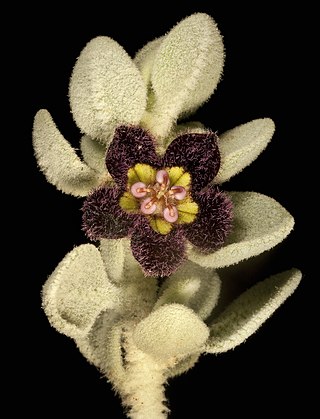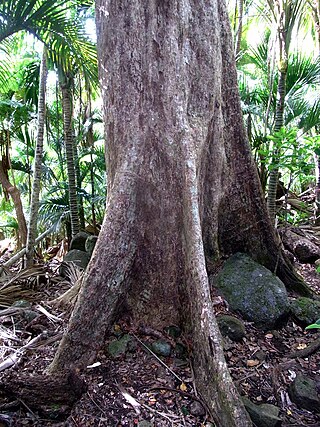Pilidiostigma is a genus of shrubs and small trees in the myrtle family Myrtaceae. All species occur in Australia and one, P. papuanum, also occurs in Papua New Guinea. They are not generally known to horticulture. The species P. sessile is rare.

Castanospora is a monotypic genus of trees, constituting part of the plant family Sapindaceae. The sole species Castanospora alphandii, commonly known as brown tamarind, grows naturally in the Australian rainforests of north-eastern New South Wales and eastern Queensland as far north as the Wet Tropics rainforests of north-eastern Queensland.

Rhododendron lochiae is a species of plant in the family Ericaceae, and is one of only two species of the genus Rhododendron that are native to Australia. It is found only in restricted areas of mountain–top cloud forest habitats within the Wet Tropics of Queensland World Heritage Site. The other species, Rhododendron viriosum, was only formally classified as a separate species in 2002.

Pherosphaera fitzgeraldii, commonly known as the Blue Mountains pine or dwarf mountain pine is a species of conifer in the family Podocarpaceae. It is found only in New South Wales, Australia. The entire natural habitat is in the Blue Mountains, from Katoomba to Wentworth Falls, growing almost exclusively in the splash zones of waterfalls, and on the southern aspect of sandstone nearby.
Atriplex bunburyana, commonly known as silver saltbush, is a species of saltbush endemic to Western Australia.

Muellerolimon salicorniaceum, the sole species in genus Muellerolimon, is a succulent perennial herb or shrub that grows on salt mudflats in Western Australia.
Hannafordia is a genus of flowering plants native to Australia

Richea is a genus of 11 species of flowering plants in the family Ericaceae. Nine of the species are endemic to Tasmania and the other two are endemic to the south-east of the Australian mainland.
Trochocarpa clarkei, commonly known as lilac berry, is a rare flowering plant in the family Ericaceae. It is endemic to sub-alpine areas of Victoria in Australia. It is a shrub which grows to around 30 cm high. The flowers are maroon with a greenish base. The fruits, which appear in autumn, are about 8 mm in diameter. These are eaten by small mammals and birds. The species occurs in subalpine areas of the southern highlands, often in association with Eucalyptus pauciflora.

Anthotroche is a genus of shrubs in the family Solanaceae. The genus is endemic to Western Australia.

Litsea bindoniana, known as the big-leaved bollywood is a rainforest tree in the laurel family. A small to medium-sized bushy tree endemic to the rainforests of tropical Queensland, Australia. It features large leaves with attractive yellow venation, 25 cm (10 in) long by 10 cm (4 in) wide. They are dark green above, and paler and somewhat hairy below. The leaf stalks are hairy. The small greenish flowers are fragrant and occur from March to May. They are followed by fruits which mature from September to October, being a black drupe. Regeneration is from fresh seed, after removing the fleshy aril around the seed.

Alectryon tomentosus, commonly known as the hairy birds eye, red jacket or woolly rambutan, is a rainforest tree of the family Sapindaceae found in eastern Australia. The specific epithet tomentosus refers to the hairy leaves and hairy young shoots.

Pachymitus is a monotypic plant genus in the mustard family Brassicaceae. The sole species is Pachymitus cardaminoides, commonly known as sand cress, which is native to Australia. It occurs in the states of New South Wales, Victoria and South Australia.
Mount Wellington is a mountain located to the north-east of Licola in Victoria, Australia. It is on the border of the Alpine National Park and Avon Wilderness Park. The Avon River rises on its south-eastern slopes.

Syzygium cormiflorum, commonly known as the bumpy satinash, is a species of Syzygium tree endemic to Queensland in northeastern Australia.

Syzygium fullagarii, commonly known as the scalybark, is a relatively large tree in the family Myrtaceae. It is found only on Lord Howe Island. It grows to 20 metres tall, up to an altitude of 400 metres above sea level in sheltered areas, often in rainforest. The bark is reddish brown, usually flaking to the touch. The base of the tree is often heavily buttressed. Known for many years as Cleistocalyx fullagarii, however, in recent times it has been placed in the large genus Syzygium.

Ozothamnus cuneifolius, commonly known as wedge-leaf everlasting or wedge everlasting, is a shrub in the family Asteraceae. It is native to forests of the south-east of New South Wales and Gippsland in Victoria in Australia.

Toechima daemelianum, commonly known as cape tamarind, is an evergreen tree from north-east Queensland in Australia. It grows up to 13 metres high and a trunk which may be up to 20 cm wide.

Blepharocarya is a genus of trees from northern Australia, in the family Anacardiaceae. They are dioecious trees with opposite leaves, a trait rather unusual within the Anacardiaceae.

Lithomyrtus obtusa, commonly known as beach myrtella, is a flowering plant species in the myrtle family, Myrtaceae. It occurs in coastal areas in New Guinea and Queensland, Australia.















